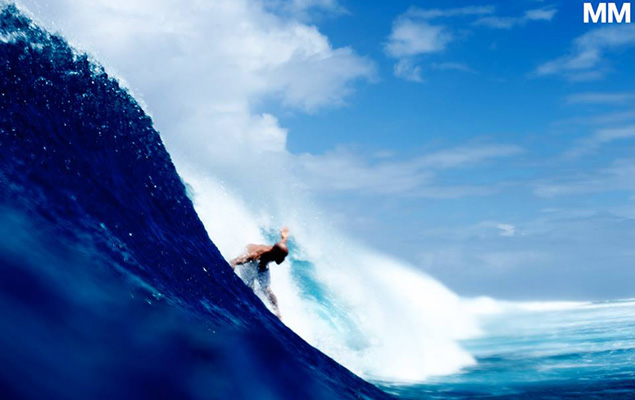
Kelly Slater takes the drop. Photo: Morgan Maassen
Morgan Maassen has climbed the ranks of professional surf photographers faster than any of his contemporaries. Growing up in Santa Barbara, he became casually acquainted with Bobby Martinez, Tom Curren, and Dane Reynolds through the proximity of shared surf sessions at and around Rincon. When an injury required Morgan to stay out of the water, he picked up a video camera and began filming surfing. He spent over a year filming, torrented Adobe Premiere, and, at the age of 16, made a surf film. With his appetite whet for photography and travel, he tested out of high school early, quit his job, and bought a plane ticket. He went to Australia, Brazil, Fiji, and Europe. He surfed along the way and documented the journey with a Super 8 camera and couple of still cameras.
Morgan recounts that experience by saying, “I came back and I organized my portfolio and started running a blog and a website. I started getting emails from magazines and companies asking to use my work. It all came very suddenly, but I remember feeling that I kind of flipped own switch and made an intentional decision to put effort into it. I was about 19 at that time, when I got serious about photography.”
You built your career working Kelly and Dane. How did those relationships develop?
When I was 16 or 17 filming around Santa Barbara, I had a personal relationship with Tom and Bobby, some of the best local kids, like the Coffin kids and what not. This was right when Kelly was coming up to Santa Barbara because he was dating Kalani [Miller]. Through word of mouth, I’d hear that he might be coming to surf Rincon, so I didn’t really have a working relationship with Kelly but I could audit his sessions.
I remember seeing an edit of Kelly surfing Rincon that you made. It was the first time I recall seeing your name.
Yeah, that day was totally random. A friend from CI (Channel Islands Surfboards) said that Kelly was in town. I went down to Rincon to surf and it was actually quite good. I paddled out for a couple waves and sure enough Kelly paddles out after my fourth wave so I ran in and grabbed my camera. He was testing a certain board and, in the course of that hour and a half, he surfed so well and so tight that I was able to create an edit that got about 1.3 million views.
Did you intend to move away from filmmaking and into still photography?
Not at all. I’ve always dreamed of being a filmmaker and I still do. Photography just got so serious so fast. I guess it’s because the style that I put time into developing cinematically transferred over immediately into photography.
What does your schedule look like? Give me a snapshot of the schedule of a pro surf photographer.
I work full-time for Quiksilver as a photographer and filmmaker. Since I don’t work 9-5 in the office like the art directors and marketing people do, we’ve devised a schedule where I work 100 days a year. So any day out of the year, out of the 100 days, they can tell me where to go and what to shoot and I’m on the clock the entire time during those days. I could be swimming 8 hours or I could be shooting product in the middle of Panama City for 8 hours. But then the other 265 days out of the year I’m free to work for any other non-competitive brand as well as any magazine. So I’m doing a lot of lifestyle, commercial, and fashion work outside of the surf industry.
How has Instagram changed the professional landscape?
I’ve used Instagram and Twitter to let out my personality. I couldn’t help it because it’s so much fun. I love Instagraming photos of my dog and goofing around with my friends. Through that I think that it’s made me more personable which in weird way has defined my work even more for people who are interested in observing it.
With the digital platform, there is a surplus of work on display. Do you see any danger in just shooting a bunch of stuff and putting it on the web?
Totally. As a photographer, I think it’s not so much about the photos that you do show, but rather the photos that you don’t show. You’re only as good as your worst photo. So that’s why I think the people that flood social media and flood blogs and have poorly curated websites, it says so much. One of the areas that I put a lot of effort into that I didn’t expect was ensuring that the work that I did display was my best work. I don’t put out as much as possible to try to get as many hits as possible. Instead, I try to put out work that I’m proud of. For example, I think that Kai Neville has done that with his filmmaking. He has a quarter as many web clips as anyone else, but his work is unanimously regarded as the best. In the 21st century with social media, you’re a brand now. You’re not just a photographer that hands photos to a photo editor. Shooting photos is just 10% of the job, the rest marketing yourself. You really have to put a lot of time into curating your image and your brand and your work.

